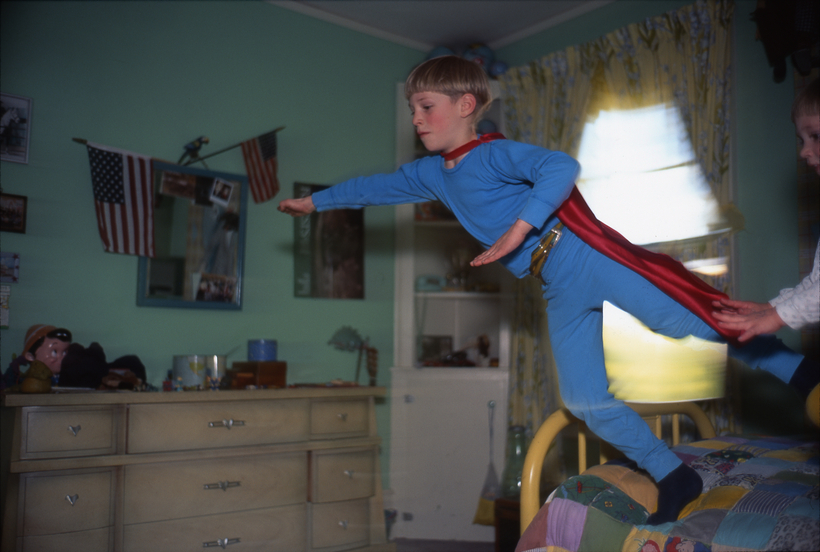After viewing Nan Goldin’s pair of slideshows, “Memory Lost” and “Sirens,” at Marian Goodman Gallery in 2019, Moderna Museet chief curator Fredrik Liew thought, She’s a filmmaker.
“Memory Lost” probes the dire realities of drug addiction, featuring voice-overs and clips from Goldin’s own battle. “Sirens,” produced concurrently, uses surreal found footage to evoke the ecstasy before the iron fog. Though Goldin’s foray into film seemed at first to Liew like a new step in her photography practice, he then reconsidered the artist’s “The Ballad of Sexual Dependency,” a compilation of several hundred still photographs sequenced into thematic “chapters” and set to a soundtrack including the Velvet Underground and Maria Callas. What, essentially, is “The Ballad of Sexual Dependency” if not a film?, he wondered.
During the early months of the pandemic, Liew proposed a retrospective presenting Goldin’s slideshows through a filmmaking lens. “I had no idea how she would respond to that,” Liew says. The artist was not only game, but she had been discussing the exact idea with her studio. “I make films out of stills and I have the freedom to re-edit and update, which films don’t have,” Goldin said during a Stockholm press conference for “Nan Goldin: This Will Not End Well,” on now at the Moderna Museet.

Each of the six slideshows on display is freshly edited and has not been shown previously; despite its long history, “The Ballad of Sexual Dependency” has never been screened the same way twice. At Moderna Museet, the slideshows live inside a “village” of screening rooms designed by the architect Hala Wardé to evoke the environments where they were first screened: “The Ballad of Sexual Dependency” takes place in a cinema, while “Sisters, Saints & Sibyls” plays at eye level on a platform, similar to its staging at the Pitié-Salpêtrière hospital, in Paris, the site of Charcot’s hysteria research. Photography inside the screening rooms is strictly prohibited and functionally prevents the images from circulating on social media without the context Goldin has created.
This retrospective feels particularly retrospective because Goldin, 69, no longer takes pictures, and the slideshows are only as elastic as Goldin’s memory; in both cases, that elasticity is contingent on self-revision. “I just want to make it true to how I feel now,” Goldin said at the press conference. Re-edited from a different perspective, a slideshow “becomes a unique piece. And it’s completely present at the time.”

“This Will Not End Well” marks the artist’s first museum show since launching PAIN (Prescription Addiction Intervention Now), the activist organization responsible for expunging the Sackler dynasty from the art world. It coincides with the theatrical release of Laura Poitras’s documentary All the Beauty and the Bloodshed, which chronicles this activism and won the Golden Lion at this year’s Venice Film Festival.
The same year she began talks with Liew—2020—Goldin taped five months of interviews with Poitras under the condition that she “would have the ability to edit them later,” Goldin said. “She was able to go very, very deep, sort of like a therapist without a psychiatrist there.” Though Goldin originally did not want to see All the Beauty and the Bloodshed, she screened it six months ago and “worked intensely” on a new edit with her collaborator Alex Kwartler. “Because it’s my voice speaking, with my imagery, I had to make sure it was saying my truth,” she said. (Goldin was also the music consultant.)

The film, per Goldin, is a testament to the power of grassroots activism. “It’s a big deal to bring down billionaires in this age,” she said. “A small group of 12 people with big voices can actually move mountains.”
The show, too, is shot through with activism—as a climate measure, Moderna Museet is not shipping work for any of its 2022 temporary exhibitions. Per Goldin, its director, Gitte Ørskou, “has talked to me about her ethical stance on museums, which, of course, I’m really interested in, having fought museums for three years.”
“It’s different than in America, where everyone’s taking dirty money,” Goldin said. “I’m happy to hear that she doesn’t do that. I mean, underneath billionaires is usually a few bodies.” —Kate Dwyer
“Nan Goldin: This Will Not End Well” will be on view at Moderna Museet until February 26, 2023, before traveling to Stedelijk Museum, in Amsterdam; Neue Nationalgalerie, in Berlin; and Pirelli HangarBicocca, in Milan
All the Beauty and the Bloodshed will hit theaters on November 23
Kate Dwyer is a journalist whose work has appeared in The New York Times, The New Yorker, The Wall Street Journal, The Cut, and elsewhere

 Discover
Discover